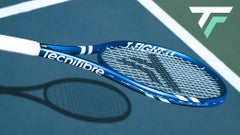How to Keep Score in Tennis
If you're wondering how to keep score in tennis, we're here to help. We'll cover how to keep a score in a game, what a tennis set is and other scoring rules. By the end of this article, we hope you will be able to call the tennis score with confidence!
Fundamentals of the Tennis Points System
In a tennis match, there are games and sets. A game is won by the first to four points (winning by two points). To win a set, a player must be the first to win six games (and win by two games). Typically a match is won by winning two sets. Read on for how to say the score and more details on how the scoring system works.
How to Start and Score a Game: Love, 15, 30, 40
You will always start a game on the deuce side. The next point you will start on the ad side.
For quick reference, the deuce side is the right hand side of the court (when you are facing the net), and the ad side is the left side when facing the net. For more information, check out our guide to tennis terms.
The server will always call the score and say his or her score first. To win a game, a player must win four points (with some exceptions that we'll explain in a bit). In tennis, the points in a game aren't simply 0, 1, 2 and 3. Instead, you will hear Love, 15, 30, 40. For example, if the server wins the first of a game, the score is called 15-Love. Or, vice versa, if the returner wins the first point of the game, the score is Love-15.
English to Tennis Translation
| Points | Score |
| 0 | Love |
| 1 | 15 |
| 2 | 30 |
| 3 | 40 |
When you have a tied score, in tennis that is called "all." For example, if each player has won a single point (called 15), the server will call the score 15 All. Two points each is 30 All. But in tennis, the score when you get to 3-3 is not 40 All. That score is called "deuce."
English to Tennis Translation
| Points | Score |
| 1-1 | 15 All |
| 2-2 | 30 All |
| 3-3 | Deuce |
You need to win the game by two points. Once at deuce, you will begin to use "Advantage" or "Ad." If the server wins the deuce point, the next point is called "Ad In." If the server wins the Ad point, the game is over, and the server "held" serve. However, if the returner wins the next point, the score goes back to deuce. When the returner wins the deuce point, the score is called "Ad Out." When a returner wins a game, we say the returner "broke" serve, meaning the serving player lost the game.
Tennis Sets Explained
Now that we've gone over how to keep score in games, we'll cover sets. A typical tennis set is won by the first player to six games, winning by two. That means a player can't win a set 6-5. That set isn't quite over yet! If the leading player wins the next game to make it 7-5, the set is now won. However, if the other player brings the set score to 6-6, a tiebreaker is played.
Before we dive into how to play a tiebreaker, let's talk about some key aspects of playing a set.
- At the start of each game, the server calls out the set score.
- After each odd game, players will switch sides, crossing to the other side of the net.
- You will play best two out of three sets (unless you're a pro playing the biggest tournaments!).
How to Play a Tennis Tiebreaker
As we mentioned, if your set score reaches 6-6, you will need to play a tiebreaker. The scoring in tiebreakers especially is a bit confusing to track, but after you play a few, it becomes more natural and easier to remember. We recommend practicing a few tiebreakers to get the hang of the scoring.
To start a tiebreaker, treat it like it's just the next game to determine who serves first. So the player who was returning the previous game serves the first point. Let's call this player A.
Player A will serve the tiebreaker's first point, starting on the right (deuce) side. For the second and third points, player B will serve, starting on the left (ad) side. From there on out, each player will serve two points and always start their turn on the left side with their second point being on the right side.
A typical tiebreaker is won by the first one to 7 points, winning by 2. In a tiebreaker, you will use normal numbers 1, 2, 3, etc. for the score ... and not use 15, 30, 40.
Hang in there with us because there is one more nuance to remember for tiebreakers. After every sixth point, players will switch sides of the net.
Quick tiebreaker review:
- The first person to serve in a tiebreak gets to serve one point only before it's the other player's turn. This point is started on the right side.
- After the first point, both players get two turns to serve, first from the left side and then the right.
- Players will switch sides of the net after every sixth point.
- A typical tiebreaker is played first to 7 points, winning by 2.
Pro Tip: If you're not sure which side you should be serving to, add up the tiebreaker score. If the sum is even, serve from the right side; if it's odd, serve from the left.
Winning a Tennis Match
How many games do you play in tennis to win a match? You have to win two sets, so you're at least playing 12 games to win. That would have you winning 6-0, 6-0 (tennis players like to call that a double bagel). But you could play as many as 36 games, plus three tiebreakers in one match!
This article is written as if you were playing a singles match. If you're playing doubles, it works the same, but you just serve in order of player A, B, C and D, then back the start of the lineup!
Quick Guide to Tennis Scoring
- To win a match, you must win two sets.
- Each set is the first player (or team) to six games, winning by two.
- Game scores use Love, 15, 30 and 40 instead of 0, 1, 2 and 3. To win the game, a player must win four points.
- Tied scores in a game are called by saying "all." One point for each player, for example, is 15 All. 40-40 (or 3-3 in points) is called deuce.
- If the score is deuce, a player needs to win two points in a row to win the game.
- Switch sides of the net after every odd game played.
- Play a tiebreaker at 6-6.
- After the match is complete, head to the net to shake hands (or gently tap racquets) with your opponent. "Good match!"
- Have fun out on court! The more matches you play, the easier it becomes to remember how to keep score in tennis.













